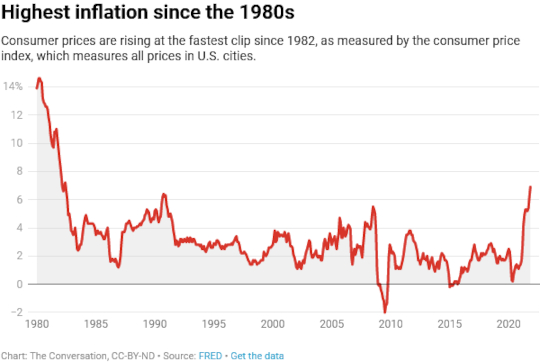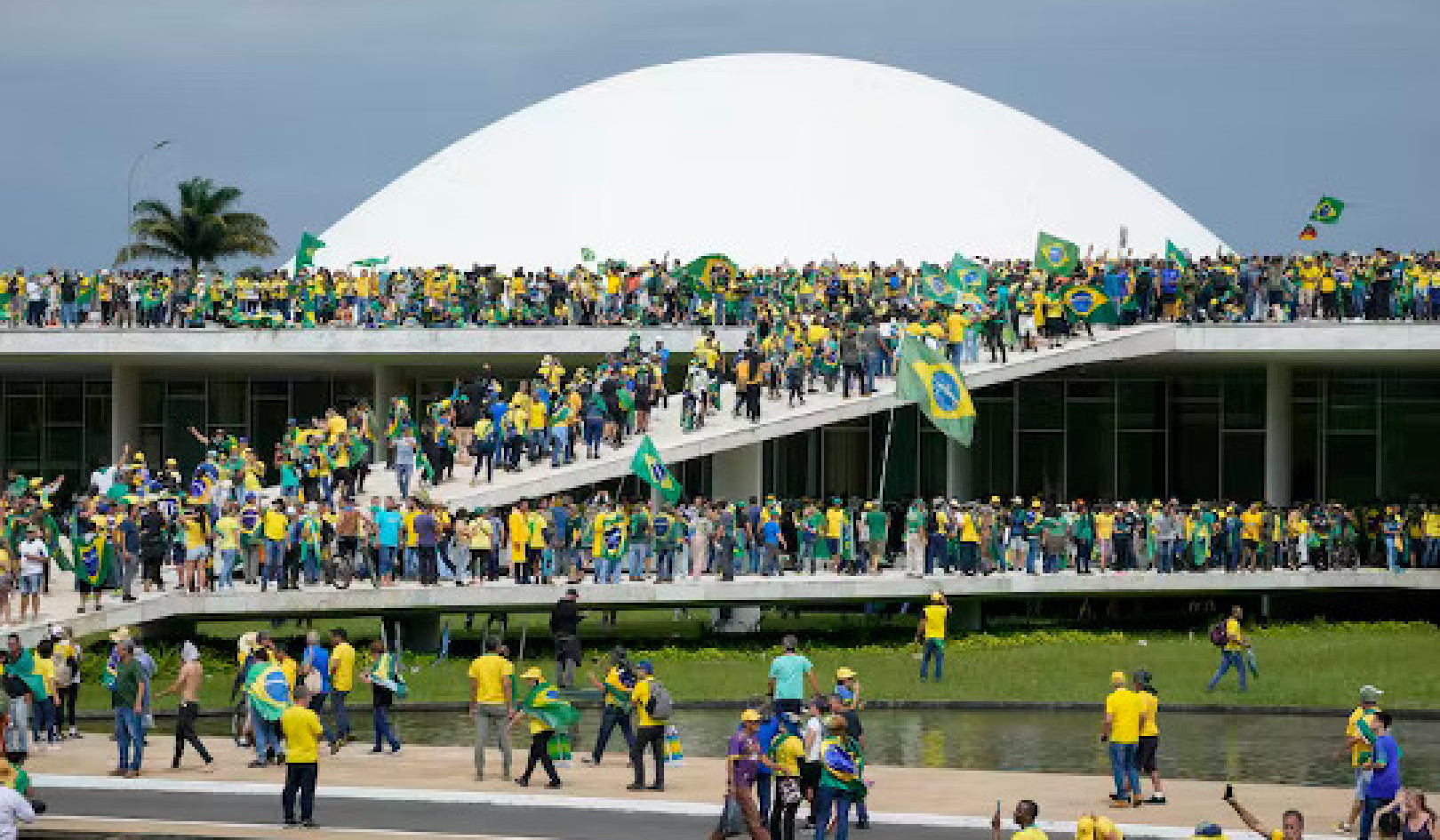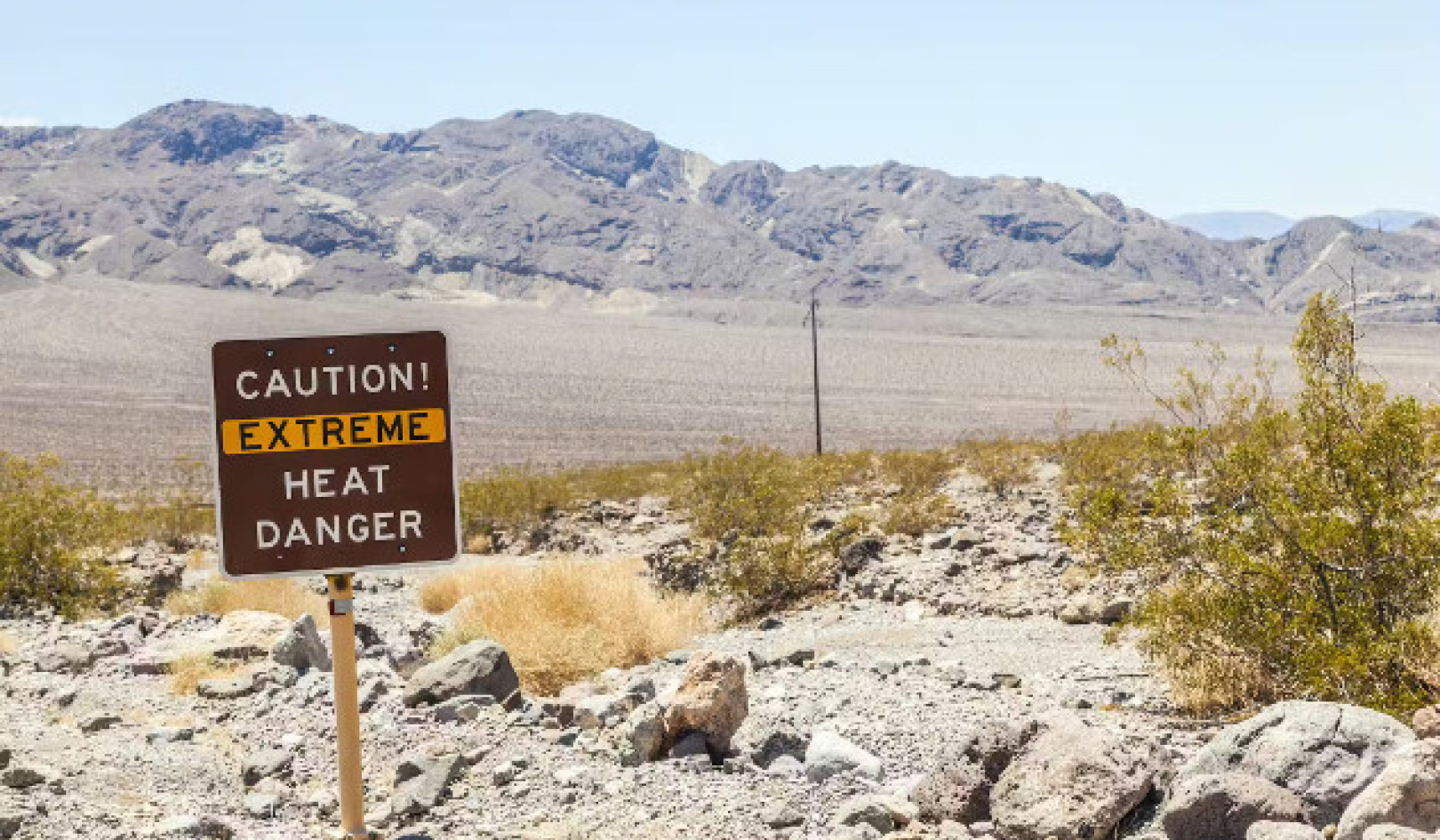
Do you get the metaphor? Edwin Remsberg/The Image Bank via Getty Images
One of the main concerns raised by critics of President Joe Biden’s Build Back Better plan is that it will drive up inflation, which is already running at the fastest pace in four decades.
The Senate is currently considering a roughly US$2 trillion bill passed by the House that would spend money on health care, education, fighting climate change and much else over the next decade. But Republicans and a handful of Democrats like Sen. Joe Manchin of West Virginia argue the risk that more spending could push inflation even higher is too great.
As an economist, I believe these concerns are likely overblown. Here’s why.
Putting $2 trillion in context
High inflation is clearly a problem at the moment – as the Federal Reserve’s Dec. 15, 2021, decision to accelerate its withdrawal of economic stimulus signals.
The most recent statistics show inflation, as measured by the annual increase in the Consumer Price Index, was 6.8% in November 2021. This is the highest level since 1982 – yet still a long way from the double-digit inflation experienced back then.

The question, then, is: Could an additional large spending increase cause inflation to accelerate further?
To answer this, it’s useful to put the numbers in some context.
The price tag of the Build Back Better plan passed by the House of Representatives is about $2 trillion, to be spent over a 10-year period. If the spending is spread out evenly, that would amount to about $200 billion a year. That’s only about 3% of how much the government planned to spend in 2021.
Another comparison is to the gross domestic product, which is the value of all goods and services produced in a country. U.S. GDP is projected to be $22.3 trillion in 2022. This means that the first year of the bill’s spending would be about 0.8% of the GDP.
While that doesn’t sound like much either, it’s not insignificant. Goldman Sachs estimates U.S. economic growth at 3.8% in 2022. If the increased spending translated into economic activity on a dollar-for-dollar basis, that could lift growth by over one-fifth.
[More than 140,000 readers get one of The Conversation’s informative newsletters. Join the list today.]
But what really matters here is how much the bill would spend in excess of any taxes raised to pay for the program. The higher taxes on the wealthy and corporations that the House version of the bill calls for would reduce economic activity – by taking money out of the economy – offsetting some of the impact of the spending that would stimulate it.
The Congressional Budget Office estimates that the bill would increase the deficit by $150.7 billion over a decade, or about $15 billion a year. Again assuming this is spread evenly over the 10 years, it would amount to less than one-tenth of 1% of GDP.
In other words, even if the proposed spending has an unusually large impact on the economy, it would still be barely noticeable on a macro level.
But it won’t reduce inflation either
Some proponents of the bill – including the White House and some economists – have gone further. They have argued that the proposed spending package would actually reduce inflation by increasing the productive capacity of the economy – or its maximum potential output.
This seems implausible to me, at least given the current level of inflation. Historical evidence shows a more productive economy can grow more quickly with relatively little upward pressure on prices. That’s what happened in the U.S. in the 1990s, when the economy grew strongly with little inflation.
In addition, it takes time for investments like those in the bill to translate into gains in productivity and economic growth – meaning many of these impacts will be slow to materialize.
Current inflation is likely an acute problem reflecting supply chain disruptions and pent-up demand, challenges that won’t be resolved by expanding the economy’s productive capacity five or more years down the road. But again, neither would inflation likely get any worse by spending $2 trillion to improve access to affordable child care, fight climate change and increase health care coverage.
Whatever the arguments for or against passage of the bill, I don’t believe its potential impact on inflation should be one of them.![]()
About The Author
Michael Klein, Professor of International Economic Affairs at The Fletcher School, Tufts University
This article is republished from The Conversation under a Creative Commons license. Read the original article.
Recommended books:
Capital in the Twenty-First Century
by Thomas Piketty. (Translated by Arthur Goldhammer)
 In Capital in the Twenty-First Century, Thomas Piketty analyzes a unique collection of data from twenty countries, ranging as far back as the eighteenth century, to uncover key economic and social patterns. But economic trends are not acts of God. Political action has curbed dangerous inequalities in the past, says Thomas Piketty, and may do so again. A work of extraordinary ambition, originality, and rigor, Capital in the Twenty-First Century reorients our understanding of economic history and confronts us with sobering lessons for today. His findings will transform debate and set the agenda for the next generation of thought about wealth and inequality.
In Capital in the Twenty-First Century, Thomas Piketty analyzes a unique collection of data from twenty countries, ranging as far back as the eighteenth century, to uncover key economic and social patterns. But economic trends are not acts of God. Political action has curbed dangerous inequalities in the past, says Thomas Piketty, and may do so again. A work of extraordinary ambition, originality, and rigor, Capital in the Twenty-First Century reorients our understanding of economic history and confronts us with sobering lessons for today. His findings will transform debate and set the agenda for the next generation of thought about wealth and inequality.
Click here for more info and/or to order this book on Amazon.
Nature's Fortune: How Business and Society Thrive by Investing in Nature
by Mark R. Tercek and Jonathan S. Adams.
 What is nature worth? The answer to this question—which traditionally has been framed in environmental terms—is revolutionizing the way we do business. In Nature’s Fortune, Mark Tercek, CEO of The Nature Conservancy and former investment banker, and science writer Jonathan Adams argue that nature is not only the foundation of human well-being, but also the smartest commercial investment any business or government can make. The forests, floodplains, and oyster reefs often seen simply as raw materials or as obstacles to be cleared in the name of progress are, in fact as important to our future prosperity as technology or law or business innovation. Nature’s Fortune offers an essential guide to the world’s economic—and environmental—well-being.
What is nature worth? The answer to this question—which traditionally has been framed in environmental terms—is revolutionizing the way we do business. In Nature’s Fortune, Mark Tercek, CEO of The Nature Conservancy and former investment banker, and science writer Jonathan Adams argue that nature is not only the foundation of human well-being, but also the smartest commercial investment any business or government can make. The forests, floodplains, and oyster reefs often seen simply as raw materials or as obstacles to be cleared in the name of progress are, in fact as important to our future prosperity as technology or law or business innovation. Nature’s Fortune offers an essential guide to the world’s economic—and environmental—well-being.
Click here for more info and/or to order this book on Amazon.
Beyond Outrage: What has gone wrong with our economy and our democracy, and how to fix it -- by Robert B. Reich
 In this timely book, Robert B. Reich argues that nothing good happens in Washington unless citizens are energized and organized to make sure Washington acts in the public good. The first step is to see the big picture. Beyond Outrage connects the dots, showing why the increasing share of income and wealth going to the top has hobbled jobs and growth for everyone else, undermining our democracy; caused Americans to become increasingly cynical about public life; and turned many Americans against one another. He also explains why the proposals of the “regressive right” are dead wrong and provides a clear roadmap of what must be done instead. Here’s a plan for action for everyone who cares about the future of America.
In this timely book, Robert B. Reich argues that nothing good happens in Washington unless citizens are energized and organized to make sure Washington acts in the public good. The first step is to see the big picture. Beyond Outrage connects the dots, showing why the increasing share of income and wealth going to the top has hobbled jobs and growth for everyone else, undermining our democracy; caused Americans to become increasingly cynical about public life; and turned many Americans against one another. He also explains why the proposals of the “regressive right” are dead wrong and provides a clear roadmap of what must be done instead. Here’s a plan for action for everyone who cares about the future of America.
Click here for more info or to order this book on Amazon.
This Changes Everything: Occupy Wall Street and the 99% Movement
by Sarah van Gelder and staff of YES! Magazine.
 This Changes Everything shows how the Occupy movement is shifting the way people view themselves and the world, the kind of society they believe is possible, and their own involvement in creating a society that works for the 99% rather than just the 1%. Attempts to pigeonhole this decentralized, fast-evolving movement have led to confusion and misperception. In this volume, the editors of YES! Magazine bring together voices from inside and outside the protests to convey the issues, possibilities, and personalities associated with the Occupy Wall Street movement. This book features contributions from Naomi Klein, David Korten, Rebecca Solnit, Ralph Nader, and others, as well as Occupy activists who were there from the beginning.
This Changes Everything shows how the Occupy movement is shifting the way people view themselves and the world, the kind of society they believe is possible, and their own involvement in creating a society that works for the 99% rather than just the 1%. Attempts to pigeonhole this decentralized, fast-evolving movement have led to confusion and misperception. In this volume, the editors of YES! Magazine bring together voices from inside and outside the protests to convey the issues, possibilities, and personalities associated with the Occupy Wall Street movement. This book features contributions from Naomi Klein, David Korten, Rebecca Solnit, Ralph Nader, and others, as well as Occupy activists who were there from the beginning.
Click here for more info and/or to order this book on Amazon.






















